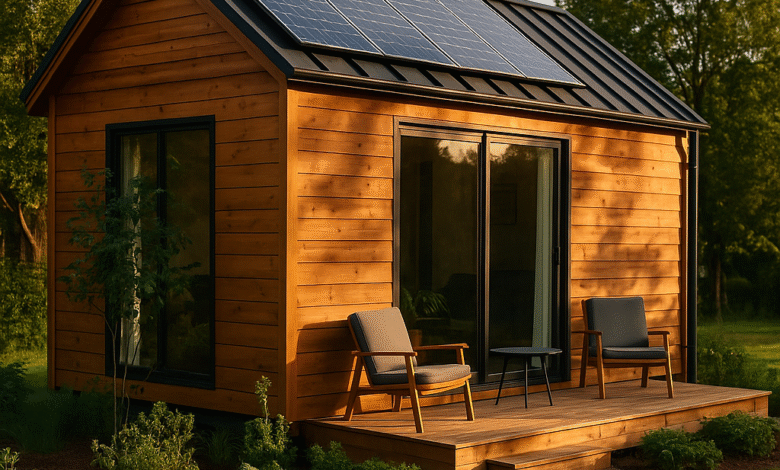
Living Small, Living Better
If you’ve been scrolling through YouTube or HGTV lately, chances are you’ve seen families showing off their brand-new Sustainable Tiny House Living USA. These little houses—often under 400 square feet—are popping up all over the United States. From off-grid cabins in Colorado to stylish trailer homes parked outside Austin, Texas, people are rethinking what “home” really means.
Why? Well, for some, it’s about escaping sky-high mortgage payments. For others, it’s the appeal of a simpler, greener lifestyle. And for many Americans, it’s both. Tiny houses can be surprisingly affordable, easier to maintain, and, when done right, incredibly sustainable.
But it is here: Living Tiny takes some creativity. So, if you are thinking about joining the movement-or you already have a small house and want to make it more environmentally friendly-these tips are for you.
1. Build smart with durable material
One of the first options to you is. Traditional houses eat lots of new wood, concrete and plastic. A small house gives you a chance to go to greenery from day one.
- The wooden attached from the barn or the old floor adds rustic attraction when reducing waste.
- Bamboo floring is a favorite-it is renewable and keeps well in a high-trough spot.
- Recycled metal siding or roof gives durability with low environmental effects.
- Paints with “Lo Woh” maintain your indoor air fresher (no more heavy chemical odor).
If you are in states such as Oregon or Washington, check local non -profit stores such as Habitat for Humanity Restors. They often sell the material recurred at a fraction of the cost.
2. Power Up the Green Way
The average U.S. home gulps down electricity like it’s free (spoiler: it isn’t). A tiny home, on the other hand, sips power—so going renewable becomes much more doable.
- Solar panels are Go-to Choice. Even a small setup on your roof can cover the most, if not, your energy is needed.
- Like Kansas or parts of Texas, in the air, a small backyard wind turbine may be understood.
- Do not ignore energy-skilled equipment. A mini fridge that is energy star-rated can save you hundreds of dollars in years.
- If you are planning to live off-grind, add your solar panels with a battery backup system. Yes, the upfront cost can sting, but the U.S. In the federal tax credit can soften the shock.
3. Get Serious About Water Conservation
Ask anyone in Arizona or California—water is precious. A tiny house makes it easier to save water, but you still need a system.
- Rainwater collection can provide plenty of water for everyday use if you have the right filtration.
- Composting the toilet is already scary, but many small household owners swear by them. They save thousands of gallons of water in a year.
- Low-powered taps and shower heads are cheap upgrades that create a big difference.
- Gravitate systems can recycle shower and submerged water to use in gardens.
Living tiny often means living smart with every drop. And in states with water shortages, it’s not just eco-friendly—it’s necessary.
4. Storage Hacks That Keep Life Simple
One of the hardest adjustments for Americans used to big houses is storage. But here’s the secret: less stuff means less stress.
- Some tips that tiny home owners in the U.S. swear by:
- Beds with the underlying drawers keep the cloth out visually.
- Fold-down desk doubles as dining tables.
- Wall-mounted racks catch everything from bikes to utensils and pamphlets.
- Adopt a “one, one, out” rule – if you buy a new coat, donate what you don’t wear.
It may take a few months to use it, but once you do this, you will be surprised why you needed so much goods in the first place.
5. Reduce waste without thinking twice
When you are living small, there is no place for additional waste. Fortunately, the lifestyle couples of the small household naturally with low-illiterate life.
- Buy in bulk where you can. Some mason jars filled with rice and oats look clean and cut on packaging.
- Compost food scrap, even if you have only a small backyard without you.
- Instead of tossing them, reproduce or donate things.
- Switch to digital on e-book, online banking and cloud storage.
In small home villages (yes, they are present in places like Florida and Oregan), many residents established shared manure stations. It is one of the allowances of community life.
6. Rethink Transportation
Sustainability doesn’t stop at your front door. If your tiny house is on wheels, you’ll already think differently about travel. But even if it’s not mobile, consider pairing the lifestyle with greener transportation.
- An electric car or plug-in hybrid works well with a solar-powered small house.
- Bikes or e-bikes are perfect for small traffic.
- If you park near a city, check local transit options – less driving means spending less on gas.
The idea is to match your downcised house with a downcised footprint on the road.
7. Join a small home community
One of the best things about small home movement in America is a community spirit. People are not only building houses – they are constructing villages.
In places like Spar, Texas and Portland, Oregon, Tiny House Communities shared gardens, solar farms and even equipment libraries. It cuts the cost, saves resources, and makes connections.
Think about it: Instead of every householders who buy a lawnmover, a shared grass cutting machine works. This is stability with a social bonus.
8. No one tells the allowances about you
Sure, to save money and help the planet in great sound. But small people living in America also have other allowances:
- You do less time cleaning and more time to do what you love.
- The lower bills give you freedom to travel, start business, or to retire first.
- Downsizing often reduces stress – low dislocation, low worries.
- You get satisfaction to know your lifestyle lines with your values.
For many people, the real victory is not just a home – this is freedom that comes with it.
9. Challenges (and how to defeat them)
Of course, it is not all sunlight and rebuked wood. Tiny House Living comes with some headache:
- Zoning Law: Some cities do not yet allow small homes. Solution: Check local laws before purchasing land, or search for small-friendly communities.
- Space Conflict: Downering may feel heavy at first. Solution: When you are still in a large place, start falling until.
- Advance costs for solar/water systems: Yes, they are expensive. But American tax credit and state incentives can help, and over time, they pay for themselves.
Knowing these challenges makes it easy to handle them.
Wrapping It Up: Sustainable Tiny House Living USA
At its core, sustainable tiny house living in the USA isn’t about giving things up—it’s about trading clutter for freedom. By using eco-friendly materials, cutting energy and water waste, and embracing minimalist habits, you’ll shrink your footprint while gaining flexibility.
And here’s the beauty of it: you don’t need to build the perfect “Pinterest tiny home” on day one. You can start small—switch to a composting toilet, try solar panels, or just declutter your closet. Every step makes a difference.
For thousands of Americans, the tiny house dream is no longer about living with less. It’s about living better, freer, and more sustainably.


